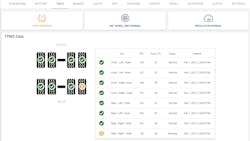Importance of advanced trailer technologies for maintenance
The trailer side of fleet operations is advancing into the future as well. Many trailers now incorporate multiple sensors to monitor trailer condition and report that information to the fleet.
Since the introduction of trailer telematics technologies, the category has expanded from offering simple location, or trailer tracking capabilities, to being able to monitor most trailer components and operations, allowing fleets to improve uptime and reduce costs. For the trailer telematics that are available today, the easier the data is presented to the fleet, the better. Many trailer operators dislike the idea of having to access multiple data streams to get the information they want. Companies like Phillips Connect are addressing that challenge with single integrated hubs and communication gateways.
Fleets get value from knowing if tires are losing air, wheel end temperatures are rising, lights are out, brakes are not functioning properly, and other faults are happening with their trailers. A trailer is not often seen on a regular basis for routine service that might catch these issues, so today’s telematics play an important role in sending notifications to alert fleet management of the problems.
But telematics have also overburdened fleets with the management of the information that is coming in; how to efficiently take care of the problem being identified. It is helpful to know that a trailer is having a brake issue, but the next step may not be as clear. If the alert goes to headquarters or some other designated department, this puts in motion a series of tasks that need to be completed: notify the driver, find a repair location in close proximity that can handle the problem, arrange an appointment to have the repair completed, direct the driver to that location, etc.
The next helpful telematics capability will be to shorten this cycle by notifying the driver directly through an in-cab information tool and automatically arranging the repair through a network of connected repair facilities that will have the necessary parts, capabilities, and resources to complete the work and get the trailer back in operation as soon as possible.
